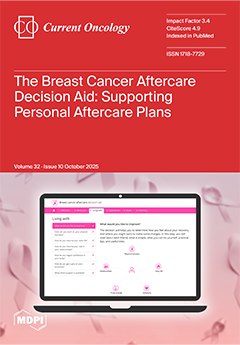Background: Trastuzumab deruxtecan (T-DXd), a HER2-directed antibody-drug conjugate, has significantly advanced the management of HER2-expressing malignancies. However, interstitial lung disease (ILD) remains a clinically significant adverse effect. Despite increasing clinical use of T-DXd, real-world data on ILD incidence, characteristics, and outcomes—particularly in Middle
[...] Read more.
Background: Trastuzumab deruxtecan (T-DXd), a HER2-directed antibody-drug conjugate, has significantly advanced the management of HER2-expressing malignancies. However, interstitial lung disease (ILD) remains a clinically significant adverse effect. Despite increasing clinical use of T-DXd, real-world data on ILD incidence, characteristics, and outcomes—particularly in Middle Eastern populations remain limited.
Methods: This retrospective study analyzed medical records of patients who received trastuzumab deruxtecan (T-DXd) at a tertiary care hospital. Data collected included demographics, tumor characteristics, prior treatments, and interstitial lung disease (ILD)-related outcomes. ILD events were identified and graded according to the Common Terminology Criteria for Adverse Events (CTCAE) version 5.0. Descriptive statistics were used to summarize baseline characteristics and ILD features. Univariate logistic regression was performed to assess potential risk factors associated with ILD development. Kaplan–Meier survival analysis was used to evaluate time-to-event outcomes, including time to ILD onset and resolution.
Results: Among 65 patients with advanced stage IV cancer (90.8% with breast cancer), 16 (24.6%) developed ILD following T-DXd therapy. The median time to ILD onset was 125.5 days. The most common presenting symptoms were dyspnea and cough (50%). A history of ground-glass opacities was associated with increased odds of ILD (OR 2.7;
p = 0.236), though not statistically significant. Patients with Grade ≥ 3 ILD had significantly lower oxygen saturation levels compared to those with milder grades (88.3% vs. 97.7%,
p = 0.049). Median time to clinical resolution was 297 days (95% CI: 77.5–516). No significant associations were observed with smoking history, pulmonary metastases, or prior thoracic radiation.
Conclusions: In this real-world cohort, ILD occurred in nearly one-quarter of patients receiving T-DXd, predominantly within the first six months of treatment. The findings highlight the importance of early respiratory symptom monitoring and pulse oximetry—particularly in patients with pre-existing pulmonary abnormalities. These results underscore the need for vigilant ILD surveillance strategies and further prospective studies to validate predictive risk factors and optimize management protocols.
Full article






